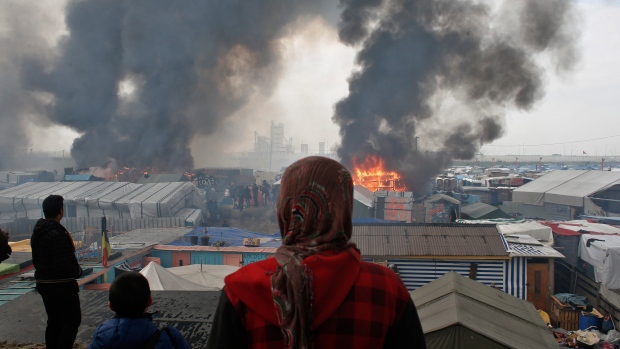
The Calais ‘Jungle’ refugee camp has been torn down. Why, and what now?
Almost 7,000 people have been evicted from the Calais refugee camp since last Monday, over 1,500 children among them. Here’s why the French and British governments dismantled the camp, and what happens now.
The camp was torn down on 'humanitarian grounds', say officials.
'The Jungle' of Calais was an unofficial refugee camp walking distance from the Channel Tunnel and port which connects northern France to southern England. Most of the migrants and refugees in the camp were there in the hope of moving to the UK, usually because of family ties and having a head-start by already speaking English.
Conditions in the camp were so dangerous to inhabitants' health that Doctors of the World classified it as a 'humanitarian emergency'. Scabies and tuberculosis were common, the water supply was contaminated, and vast amounts of people suffering from post-traumatic stress were unable to receive the treatment they needed given there was only 1 doctor per 4000 people. The size of the camp meant that unaccompanied children were at risk of and abuse.
In light of this, the decision to close the camp has been justified on humanitarian grounds.
...but economics may have played a part in the decision as well.
There's reason to believe that economic reasoning could have influenced the French and British governments' decision to tear down The Jungle.
Before the camp was built, Calais was a tourist hotspot, known for cheap eats and good wines. But reports of migrants jumping onto lorries, warnings to tourists to lock their car doors, and delayed Eurostar travel has put people off. The director of tourism for the Calais area believes visitors from the UK fell by 20% between 2014 and 2015. The constant supply of volunteers to the camp has kept up demand for hostels, cheap hotels and bars – but by and large, it’s been bad news for the local tourism industry, and Eurostar claimed they spent more than £113m on security since the arrival of migrants and refugees to the area.
In Kent, a region in southeast England connected to the tunnel, tourism has also taken a hit. When migrants and refugees tried to scale the Channel Tunnel fence and ferry workers went on strike last July, Canterbury Cathedral lost £50,000 of profit in one month.
Freight drivers on both sides of the Channel have also been affected. The Association of Calais Traders and the Freight Transport Association (FTA) have complained of financial losses. The FTA, based in the UK, estimated that haulage companies lost £700,000 a day last July when French lorry drivers blocked the port in protest.
Presumably, the hope is that shutting down the camp will bring tourism back to Calais, and end disruption to trade. But will it?
The thing is, shutting down the camp won't necessarily stop people from settling there.
French President Francois Hollande said on Tuesday that no-one will be allowed back into the camp. Construction of a £1.9m wall (dubbed the ‘Great Wall of Calais’) is set to start soon(a figure that would fund over 5000 English courses for migrants or refugees).
But this is unlikely to stop migrants or refugees attempting to cross the border. When Hungary and Slovenia in Eastern Europe built huge fences along their borders, migrants and refugees travelled by boat instead or paid smugglers to hide them in lorries. In 2002, when a very similar camp in Sangette, northern France was closed down, new arrivals began settling 10km down the coast in Calais and tried to board lorries from there instead.
And the migrants and refugees themselves, both children and adults, now face an uncertain future.
Most of the camp’s 7,000 former residents have by now been bussed to reception centres across France to have their asylum applications processed.
If a migrant or refugee’s claim for asylum is successful, they will be given ‘refugee status’. This means they can work in France, earning, spending, and paying taxes like any other French resident. If their claim for asylum is declined – either because the authorities decide that their life is not ‘in danger’ in their home country, or if they’ve already been assessed by another EU country – they will be deported.
But receiving refugee status doesn’t necessarily guarantee an easy time. In Forges-les-Bains, outside Paris, a proposed welcome centre was set on fire. Some areas are more welcoming; in Chardonnay, volunteers have started free French classes and medical examinations.
Children’s rights are slightly different. 1,500 children and teenagers left in the camp were taken to children’s homes across France on Wednesday morning. Under the ‘Dubs Amendment’, a new UK law passed in May, the most vulnerable minors under 18 will be chosen by British officials to receive British residence. Under another EU law, the Dublin Agreement III, children from the camp with family in the UK can move and live with their relatives.
But even these children’s status in the UK isn’t guaranteed. With council’s budgets overstretched, 1 in 4 are refusing to support refugee children. If the British government wants councils to take more refugees, it needs to give them more funding.
So without on-the-ground solutions to the economic insecurity migrants and refugees face back home, this probably won't solve much.
It's too soon to tell. Asylum-seekers from Sudan, Afghanistan, Iraq, Iran, Syria, Eritrea and Pakistan formed the majority of the Calais camp – and these countries all continue to be blighted by violence, terror attacks or oppressive dictators. As long as conflicts continue, it is likely a new camp will emerge elsewhere. More children are sure to arrive alone and the process will start all over again.



